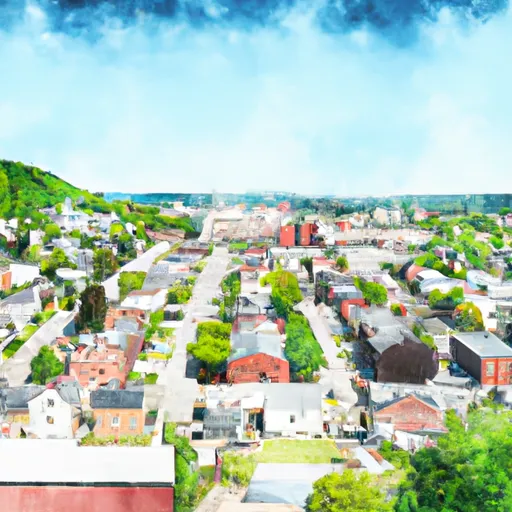-
 Snoflo Premium
Snoflo Premium
Get unlimited access to all our content
With no Ad interruptions! - Start Your Free Trial Login with existing account
W-Mifflin-Fin
Eden Index
Climate
8.3
•
Recreation
3.2
•
Community
2.4
•
Safeguard
5.0/10

West Mifflin is a borough located in Allegheny County, Pennsylvania. It has a diverse climate with warm summers and cold winters. The average high temperature in summer is around 81°F, while in winter, temperatures can drop to an average low of 19°F. Precipitation is evenly distributed throughout the year, with an annual average of 39 inches.
The hydrology constituents in West Mifflin are mainly influenced by the nearby Monongahela River. This river provides a source of water for various recreational activities like boating, fishing, and kayaking. Additionally, the area has several local parks and nature reserves, such as the Mifflin Township Community Park and South Park, which offer opportunities for hiking, picnicking, and wildlife observation.
Outdoor enthusiasts can take advantage of nearby attractions like the Allegheny County Bike Trail, which spans over 150 miles and provides an excellent opportunity for biking and jogging. The region also features golf courses, swimming pools, and sports facilities, ensuring a wide range of outdoor recreational options for residents and visitors alike.
What is the Eden Index?
The Snoflo Eden Index serves as a comprehensive rating system for regions, evaluating their desirability through a holistic assessment of climate health, outdoor recreation opportunities, and natural disaster risk, acknowledging the profound impact of these factors on livability and well-being.
Climate Health Indicator (CHI): 8.3
W-Mifflin-Fin receives approximately
995mm of rain per year,
with humidity levels near 83%
and air temperatures averaging around
11°C.
W-Mifflin-Fin has a plant hardyness factor of
6, meaning
plants and agriculture in this region thrive during a short period during spring and early summer. Most
plants will die off during the colder winter months.
By considering the ideal temperature range, reliable water supplies, clean air, and stable seasonal rain or snowpacks, the Climate Health Indicator (CHI) underscores the significance of a healthy climate as the foundation for quality living.
A healthy climate is paramount for ensuring a high quality of life and livability in a region, fostering both physical well-being and environmental harmony. This can be characterized by ideal temperatures, reliable access to water supplies, clean air, and consistent seasonal rain or snowpacks.
Weather Forecast
Streamflow Conditions
Monongahela
Area Rivers
Monongahela
Snowpack Depths
Monongahela
Reservoir Storage Capacity
Monongahela
Groundwater Levels
Recreational Opportunity Index (ROI): 3.2
The Recreational Opportunity Index (ROI) recognizes the value of outdoor recreational options, such as parks, hiking trails, camping sites, and fishing spots, while acknowledging that climate plays a pivotal role in ensuring the comfort and consistency of these experiences.
Access to outdoor recreational opportunities, encompassing activities such as parks, hiking, camping, and fishing, is crucial for overall well-being, and the climate plays a pivotal role in enabling and enhancing these experiences, ensuring that individuals can engage in nature-based activities comfortably and consistently.
Camping Areas
| Campground | Campsites | Reservations | Toilets | Showers | Elevation |
|---|---|---|---|---|---|
| Two Mile Run County Park | None | 1,304 ft | |||
| Coopers Rock State Forest | None | 2,154 ft | |||
| Chestnut Ridge Regional Park | None | 2,268 ft | |||
| Tygart Lake State Park | None | 1,516 ft |
Nearby Ski Areas
Catastrophe Safeguard Index (CSI):
The Catastrophe Safeguard Index (CSI) recognizes that natural disaster risk, encompassing floods, fires, hurricanes, and tornadoes, can drastically affect safety and the overall appeal of an area.
The level of natural disaster risk in a region significantly affects safety and the overall livability, with climate change amplifying these risks by potentially increasing the frequency and intensity of events like floods, fires, hurricanes, and tornadoes, thereby posing substantial challenges to community resilience and well-being.
Community Resilience Indicator (CRI): 2.4
The Community Resilience Indicator (CRI) recognizes that education, healthcare, and socioeconomics are crucial to the well-being of a region. The CRI acknowledges the profound impact of these elements on residents' overall quality of life. By evaluating educational resources, healthcare accessibility, and economic inclusivity, the index captures the essential aspects that contribute to a thriving community, fostering resident satisfaction, equity, and social cohesion.

